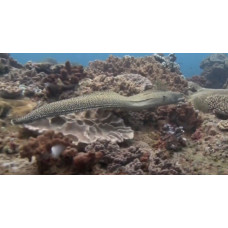Actinopterygii is a superclass of bony fishes. It unites more than 96% of living fishes. Their bodies are covered with bony scales. Only in the shell fish and on the upper blade of the caudal fin of sturgeons are ganoid scales preserved. The skeleton is partially or completely ossified. Only in sturgeons the chord is preserved, in all others the axial skeleton is represented by bony vertebrae. The jaw apparatus is movably connected to the skull (hyostylia, less often amphistylia). Paired fins uniserial type. There is no cloaca. Anal and urogenital openings are isolated. The lower Teleostei and Ganoidomorpha retain a spiral valve in the intestine and an arterial cone in the heart. They inhabit marine and fresh waters. The subclass is divided into 4 superorders: Polypteri, Chondrostei, Holostei, and Teleostei.
The oldest fossil find of Actinopterygii is 420 million years old (end of the Silurian Period). It is a predatory fish Andreolepis hedei from the Palaeonisciformes. Fossils of this species have been found in Russia, Sweden and Estonia. Actinopterygii, which had ganoid scales, were widespread in the Permian and Triassic periods. They were replaced about 200 million years ago by Teleostei, to which the vast majority (95%) of modern fishes are now attributed. In the course of long evolution, accompanied by a wide adaptive radiation, a great variety of Actinopterygii appeared.
Unlike Sarcopterygii, another class of Teleostei, Actinopterygii, as a rule, possess a bony spine, and only a few retain the chorda or its remnants. The maxillary apparatus has a movable articulation with the skull. The skin is covered with scales (ganoid, cycloid or ctenoid), sometimes bare or covered with bony plates. Choanae are absent. The fins are paired, muscular blades at the base are only in Polypteriformes. The number of dorsal fins varies from 1 to 3 (most often 1). In ancient representatives of the caudal fin heterocercal, and in younger - homocercal. Usually there is a swim bladder. Anal and urogenital openings are usually separated.
Among Actinopterygii, two major groups are distinguished: Ganoidomorpha and Teleostei. The first group includes more ancient in origin fish orders:
Acipenseriformes;
polypteriformes;
amiiformes - only one species, Amia calva;
lepisosteiformes.
Actinopterygii
Tags: actinopterygii




